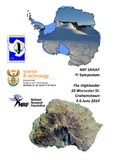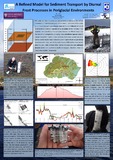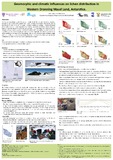
Antarctic Legacy Archive
A review of the ground thermal attributes on Marion Island and its geomorphic and climate change implications
- ALSA Home
- →
- Documents
- →
- Research: Events, Presentations, Posters
- →
- View Item
JavaScript is disabled for your browser. Some features of this site may not work without it.
| dc.contributor.author | Nel, W. | |
| dc.contributor.author | Boelhouwers, J. | |
| dc.contributor.author | Meiklejohn, I. | |
| dc.contributor.author | Hedding, D. | |
| dc.coverage.spatial | sub-Antarctic | |
| dc.coverage.spatial | Marion Island | |
| dc.date.accessioned | 2021-03-10T09:25:41Z | |
| dc.date.available | 2021-03-10T09:25:41Z | |
| dc.date.created | 2007/10/09 | |
| dc.date.issued | 2007/10/09 | |
| dc.identifier.uri | http://hdl.handle.net/123456789/28548 | |
| dc.description.abstract | Diurnal soil frost environments are mostly studied in a continental context. In contrast, the maritime sub-Antarctic possesses a highly maritime climate that has been shown to result in highly effective conditions for soil frost processes1 In addition, soil displacement by frost is now recognised as having important interactions with terrestrial ecosystems in the sub-Antarctic region and on Marion Island specifically. A review of the ground thermal attributes on Marion Island demonstrates the low diurnal and seasonal soil temperature ranges on the island. It also provides the first approximations of the altitudinal lapse rates and the general increase in soil frost activity with altitude. Lowland environments are characterized solely by diurnal freezing with a large number of surficial freeze-thaw cycles while high altitude areas are distinguished by longer term freezing events and deeper soil frost penetration associated with the zero-curtain effect and snow cover (see Boelhouwers - poster). The recorded ground temperature data indicate a rapid decrease in frost cycle frequency-intensity with depth and permafrost has not been measured. Isolated pockets of permafrost exist in valley floors above 1000 a.s.l and are linked to perennial snow and ice patches (see Boelbouwers - poster). A reduction in winter snow cover due to climate amelioration could offset some of the consequences of current climate warming on soil frost conditions. Noticeable shortcomings of the current published ground temperature dataset are, first, that data are restricted to the eastern part of the island, which is known to undergo more continental conditions than the rest of the island. Second, temperature data are lacking for the mid-altitudinal (300-600m asl) areas where ecosystem interactions are potentially greatest. Third, Island-scale aspect variations in ground temperature and, fourth, moisture and energy balance drivers of the ground climate on Marion Island, are poorly understood at present. | en_ZA |
| dc.description.sponsorship | Sponsored by the the Department of Science and Innovation(DSI) through National Research Foundation (NRF) - South Africa | en_ZA |
| dc.description.statementofresponsibility | Antarctic Legacy of South Africa | en_ZA |
| dc.format | en_ZA | |
| dc.language | English | en_ZA |
| dc.publisher | South African National Antarctic Programme (SANAP) | en_ZA |
| dc.relation | SANAP Symposium 2007 | en_ZA |
| dc.relation.ispartof | ARESSA THEME II: Climate Variability: Past, Present and Future (Posters) | en_ZA |
| dc.rights | Copyright | en_ZA |
| dc.rights | Copyright | en_ZA |
| dc.subject | Research | en_ZA |
| dc.subject | Science | en_ZA |
| dc.subject | Meetings | en_ZA |
| dc.subject | Symposium | en_ZA |
| dc.subject | SANAP Symposium 2007 | en_ZA |
| dc.subject | sub-Antarctic | en_ZA |
| dc.subject | Marion Island | en_ZA |
| dc.subject | Earth Systems | en_ZA |
| dc.subject | Research | en_ZA |
| dc.subject | Earth Science | en_ZA |
| dc.subject | Geomorphology | en_ZA |
| dc.subject | Geo Sciences | en_ZA |
| dc.subject | Earth Sciences | en_ZA |
| dc.subject | Terrestrial Science | en_ZA |
| dc.subject | Soil Frost | en_ZA |
| dc.subject | Climate Change | en_ZA |
| dc.subject | Ground Temperature | en_ZA |
| dc.subject | Soil Temperature | en_ZA |
| dc.title | A review of the ground thermal attributes on Marion Island and its geomorphic and climate change implications | en_ZA |
| dc.type | Abstracts | en_ZA |
| dc.rights.holder | Antarctic Legacy of South Africa | en_ZA |
| dc.rights.holder | Nel, W. | en_ZA |
| dc.rights.holder | Boelhouwers, J. | en_ZA |
| dc.rights.holder | Meiklejohn, I. | en_ZA |
| dc.rights.holder | Hedding, D. | en_ZA |
| iso19115.mdconstraints.uselimitation | This item and the content of this website are subject to copyright protection. Reproduction of the content, or any part of it, other than for research, academic or non-commercial use is prohibited without prior consent from the copyright holder. | en_ZA |
| iso19115.mddistributor.distributorcontact | South African National Antarctic Programme (SANAP) | en_ZA |
| iso19115.mdformat.name | en_ZA | |
| iso19115.mdidentification.deliverypoint | Antarctic Legacy of South Africa, Faculty of Science, Private Bag X1, Matieland. Stellenbosch. South Africa. | en_ZA |
| iso19115.mdidentification.electronicmailaddress | antarcticlegacy@sun.ac.za | en_ZA |
| iso19115.mdidentification.organizationname | University of Fort Hare | en_ZA |
| iso19115.mdidentification.organizationname | Uppsala University | en_ZA |
| iso19115.mdidentification.organizationname | University of Pretoria | en_ZA |
| iso19115.mdidentification.organizationname | North-West University | en_ZA |
Files in this item
This item appears in the following Collection(s)
-
Research: Events, Presentations, Posters [480]
Material directly related to official scientific and research events



